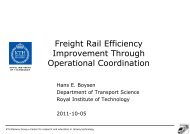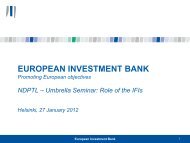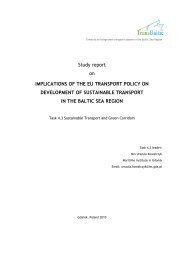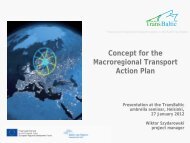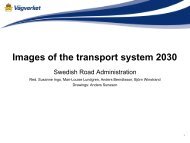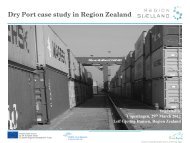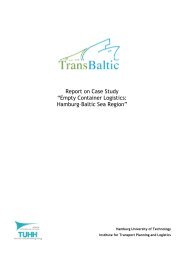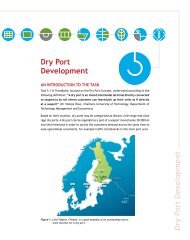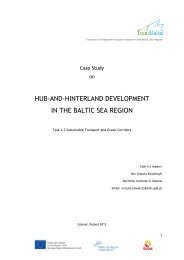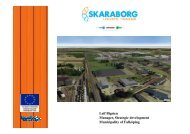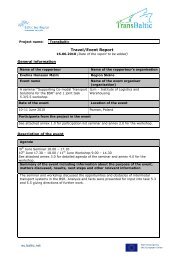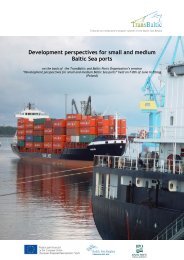Implications of new regulation regarding sulphur ... - TransBaltic
Implications of new regulation regarding sulphur ... - TransBaltic
Implications of new regulation regarding sulphur ... - TransBaltic
You also want an ePaper? Increase the reach of your titles
YUMPU automatically turns print PDFs into web optimized ePapers that Google loves.
Towards an integrated transport system in the Baltic Sea Region<br />
<strong>Implications</strong> <strong>of</strong> <strong>new</strong> <strong>regulation</strong> <strong>regarding</strong> <strong>sulphur</strong> content in ship’s fuel on maritime<br />
transport sector within Baltic Sea Region<br />
on the basis <strong>of</strong> the <strong>TransBaltic</strong> and Baltic Ports Organization’s Port Debate:<br />
<strong>Implications</strong> <strong>of</strong> the IMO <strong>regulation</strong>s on the future pattern <strong>of</strong> the cargo flow in the Baltic<br />
held on 15th June 2012 in Helsinki, Finland<br />
July 2012<br />
Photo: Port <strong>of</strong> Rauma
Towards an integrated transport system in the Baltic Sea Region<br />
Report coordinator: Baltic Ports Organization Secretariat<br />
Authors:<br />
Monika Rozmarynowska – academic teacher at Gdynia Maritime Academy<br />
Bogdan Ołdakowski, BPO Secretary General<br />
Baltic Ports Organization is made up <strong>of</strong> forty plus major ports in the nine countries surrounding the<br />
Baltic Sea. The main objective <strong>of</strong> BPO is to improve the competitiveness <strong>of</strong> maritime transport in<br />
the Baltic region by increasing the efficiency <strong>of</strong> ports, marketing the Baltic region as a strategic<br />
logistics centre, improving the infrastructure within the ports and their connections to other modes<br />
<strong>of</strong> transport.<br />
<strong>TransBaltic</strong>, as one <strong>of</strong> the few transnational projects so far, has been granted a strategic status by<br />
the authorities <strong>of</strong> the Baltic Sea Region Programme 2007-2013. The overall objective <strong>of</strong> <strong>TransBaltic</strong><br />
is to provide regional level incentives for the creation <strong>of</strong> a comprehensive multimodal transport<br />
system in the BSR. This is to be achieved by means <strong>of</strong> joint transport development measures and<br />
jointly implemented business concepts. <strong>TransBaltic</strong> is led by Region Skåne and lasts from 1 June<br />
2009 to 31 December 2012.<br />
1
Towards an integrated transport system in the Baltic Sea Region<br />
Contents<br />
Introduction ............................................................................................................................................. 3<br />
1. New <strong>regulation</strong>s concerning <strong>sulphur</strong> oxide emission from ships ....................................................... 4<br />
2. Solutions to meet <strong>new</strong> <strong>regulation</strong> ....................................................................................................... 7<br />
3. Economic effects <strong>of</strong> <strong>new</strong> IMO <strong>regulation</strong> ......................................................................................... 14<br />
4. Potential changes in future cargo flow in BSR due to <strong>new</strong> IMO <strong>regulation</strong> ..................................... 19<br />
5. New <strong>regulation</strong> and its infrastructural implications for seaports .................................................... 25<br />
Summary and conclusions ..................................................................................................................... 31<br />
2
Towards an integrated transport system in the Baltic Sea Region<br />
Introduction<br />
The report has been prepared on the basis <strong>of</strong> the presentations at the Trans Baltic and Baltic<br />
Ports Organisation’s seminar – “<strong>Implications</strong> <strong>of</strong> the IMO <strong>regulation</strong>s on the future pattern <strong>of</strong><br />
the cargo flow in the Baltic” held on 15 th June 2012 in Helsinki. The important source <strong>of</strong><br />
information and data were also studies assessing the impact <strong>of</strong> <strong>new</strong> IMO <strong>regulation</strong>s<br />
<strong>regarding</strong> <strong>sulphur</strong> limits in ships’ fuel on maritime transport sector in SECA.<br />
In October 2008 the International Maritime Organization (IMO) adopted amendments to<br />
Annex VI <strong>of</strong> the MARPOL Convention which, inter alia, strengthened the requirements on the<br />
permitted <strong>sulphur</strong> limits in ships fuels. Two sets <strong>of</strong> emission and fuel quality requirements<br />
are defined by Annex VI: (1) global requirements, and (2) more stringent requirements<br />
applicable to ships in Sulphur Emission Control Areas (SECA). Baltic Sea is included in SECA<br />
area, where as <strong>of</strong> 1 st July 2010, the maximum <strong>sulphur</strong> limit has been reduced to 1.00%, (from<br />
1.50%), while from 1 January 2015, <strong>sulphur</strong> content in ships’ fuel must be below 0.1%.<br />
New <strong>regulation</strong>s caused great concern within countries located within Baltic area. A series <strong>of</strong><br />
studies have recently been performed by various organizations to assess the implications <strong>of</strong><br />
the <strong>new</strong> <strong>sulphur</strong> standards for the shipping industry and other stakeholders. There is a great<br />
concern that <strong>new</strong> IMO <strong>regulation</strong> will lead to increase <strong>of</strong> the sea transport costs. Significant<br />
costs’ increase for transportation by sea as a consequence <strong>of</strong> using the more expensive low<br />
<strong>sulphur</strong> fuel (MGO) may reduce competitiveness <strong>of</strong> sea transport drastically and mean that,<br />
in many cases, short sea shipping will not be cost - effective. This may lead, to some extent,<br />
to a modal backshift from sea to road and even to change <strong>of</strong> directions <strong>of</strong> logistics flows in<br />
Europe in order to avoid the SECA. Switching to MGO is not the only one option to meet <strong>new</strong><br />
<strong>regulation</strong>s. Two other solutions are under development: scrubbers and LNG as a ships’ fuel.<br />
However development <strong>of</strong> such solutions will involve simultaneous development <strong>of</strong><br />
specialized facilities in ports.<br />
Generally, the <strong>new</strong> environmental <strong>regulation</strong>s are a great challenge not only to shipping<br />
industry, but also to ports within Baltic Sea Region. Report outlines the most significant<br />
consequences for maritime transport sector within Baltic Sea which have resulted from<br />
upcoming rules.<br />
3
Towards an integrated transport system in the Baltic Sea Region<br />
1. New <strong>regulation</strong>s concerning <strong>sulphur</strong> oxide emission from ships<br />
MARPOL Annex VI “Regulations for the Prevention <strong>of</strong> Air Pollution from Ships”<br />
International <strong>regulation</strong>s <strong>regarding</strong> pollution from ships are contained in the IMO<br />
“International Convention on the Prevention <strong>of</strong> Pollution from Ships”, known as MARPOL<br />
73/78. On 27 September 1997, the MARPOL Convention has been amended by the “1997<br />
Protocol” which includes Annex VI titled “Regulations for the Prevention <strong>of</strong> Air Pollution<br />
from Ships”. In particular, Annex VI regulates the matter <strong>of</strong> emission <strong>of</strong> such substances as<br />
<strong>sulphur</strong> oxides (SOx), nitrogen oxides (NOx) and particulate matters. Annex VI entered into<br />
force on 19 th May 2005 and in October 2008 IMO adopted a set <strong>of</strong> amendments to Annex VI<br />
<strong>of</strong> the MARPOL Convention.<br />
The set <strong>of</strong> amendments to Annex VI <strong>of</strong> the MARPOL Convention introduces <strong>new</strong> standards<br />
<strong>regarding</strong> emission from ships <strong>of</strong> such substances as <strong>sulphur</strong> oxides (SOx) and particulate<br />
matters and nitrogen oxides (NOx). The most stringent changes regard SOx emission.<br />
Reduction <strong>of</strong> SOx and particulate matter emission are going to be achieved by limiting the<br />
maximum <strong>sulphur</strong> content <strong>of</strong> the fuel oils used onboard. Two sets <strong>of</strong> emission and fuel<br />
quality requirements are defined by Annex VI: (1) global requirements, and (2) more<br />
stringent requirements applicable to ships in Sulphur Emission Control Areas (SECA). On the<br />
global level, <strong>sulphur</strong> cap will be reduced initially to 3.50% (from the current 4.50%), effective<br />
from 1 st January 2012; then progressively to 0.50 %, effective from 1 st January 2020 (or in<br />
2025 at the latest), subject to a feasibility review to be completed no later than 2018. Annex<br />
VI introduces much more stringent requirements for ships operated in SECA. As from 1 st July<br />
2010, the maximum <strong>sulphur</strong> limit has been reduced to 1.00%, (from 1.50%), while from<br />
1 st January 2015, <strong>sulphur</strong> content in ships’ fuel must be below 0.1 %.<br />
5<br />
Sulphur content in ships'<br />
fuel [%]<br />
4<br />
3<br />
2<br />
1<br />
0<br />
2000 2005 2010 2015 2020 2025<br />
Sox ECA<br />
global<br />
Figure 1. Sulphur Limit in Fuel<br />
4
Towards an integrated transport system in the Baltic Sea Region<br />
Date<br />
Table 1. Sulphur Limit in Fuel<br />
Sulphur Limit in Fuel<br />
in SECA (%)<br />
Date<br />
2000 1.5 % 2000 4.5 %<br />
1 st July 2010 1.0 % 2012 3.5 %<br />
2015 0.1 % 2020* 0.5 %<br />
Sulphur Limit in Fuel<br />
Global (%)<br />
* alternative date is 2025, to be decided by a review in 2018<br />
Source: MARPOL 73/78, Annex VI Regulations for the Prevention <strong>of</strong> Air Pollution from Ships<br />
At present four regions are defined as Sulphur Emission Control Area. However, it has to be<br />
noted that Emission Control Area can be designated not only for SOx and PM emission but<br />
also for NOx emission, or all three types <strong>of</strong> emissions from ships. At present The ECA<br />
established are:<br />
1. Baltic Sea area – as defined in Annex I <strong>of</strong> MARPOL (SOx only);<br />
2. North Sea area – as defined in Annex V <strong>of</strong> MARPOL (SOx only);<br />
3. North American area (expected to enter into effect 1 st August 2012) – as defined in<br />
Appendix VII <strong>of</strong> Annex VI <strong>of</strong> MARPOL (SOx, NOx and PM); and<br />
4. United States Caribbean Sea area (expected to enter into effect 1 st January 2014) – as<br />
defined in Appendix VII <strong>of</strong> Annex VI <strong>of</strong> MARPOL (SOx, NOx and PM).<br />
Figure 2. Existing and potential Emission Control Areas<br />
Source: http://blogs.dnv.com/lng/2011/02/lng-for-greener-shipping-in-north-america/<br />
5
Towards an integrated transport system in the Baltic Sea Region<br />
Moreover, other areas are considered to be designated as Emission Control Areas, for<br />
example: Mediterranean Sea, waters along the coast <strong>of</strong> Norway, Japan and Mexico.<br />
Directive 1999/32/EC (as amended by Directive 2005/33/EC)<br />
Directive 1999/32/EC (as amended by Directive 2005/33/EC) regulates the <strong>sulphur</strong> content<br />
<strong>of</strong> fuels used by maritime transport and incorporates certain international rules into EU law,<br />
as agreed under the International Maritime Organisation (IMO). However, due to revision <strong>of</strong><br />
MARPOL Annex VI in 2008, the Directive is no longer aligned with international (IMO) rules<br />
following the revision. The <strong>new</strong> MARPOL Annex VI rules on <strong>sulphur</strong> are now significantly<br />
different from the 1999/32/EC Directive:<br />
• the Directive allows ships to use fuels with a <strong>sulphur</strong> content <strong>of</strong> up to 1.5% when<br />
operating in the SECAs, while the <strong>new</strong> MARPOL Annex VI allows a maximum <strong>sulphur</strong><br />
content <strong>of</strong> 1.00% and as <strong>of</strong> January 2015 a maximum <strong>sulphur</strong> content <strong>of</strong> 0.1%;<br />
• the Directive <strong>of</strong>fers a strong operator compliance mechanism, while MARPOL Annex<br />
VI has no such enforcement mechanism;<br />
• the Directive allows for a limited range <strong>of</strong> equivalent emission abatement methods<br />
when compared to the revised MARPOL Annex VI.<br />
However, European Union Directive 2005/33/EC, introduces more stringent rules for ships<br />
while at berth in European Community ports. As from 1 st January 2010, ships at berth in all<br />
ports <strong>of</strong> the European Community shall not use marine fuels with a <strong>sulphur</strong> content<br />
exceeding 0.1% by mass. Due to some technical problems that occurred, ships have been<br />
given a transitional period till the end <strong>of</strong> August 2010 to make the necessary technical<br />
changes. However, from 1 st September 2010 all ships covered by directive must obey the<br />
rules. Additionally, with effect from 1 st January 2010, Member States shall ensure that<br />
marine gas oils are not placed on the market in their territory if the <strong>sulphur</strong> content <strong>of</strong> those<br />
marine gas oils exceeds 0.1 % by mass.<br />
In order to ensure coherence with international law as well as to secure proper enforcement<br />
<strong>of</strong> <strong>new</strong> globally established <strong>sulphur</strong> standards in the Union, the Commission proposes that<br />
6
Towards an integrated transport system in the Baltic Sea Region<br />
the provisions <strong>of</strong> Directive 1999/32/EC be aligned with the revised Annex VI to MARPOL. In<br />
particular: 1<br />
• Incorporation into the directive <strong>of</strong> the 2008 amendments to Annex VI to MARPOL<br />
concerning the <strong>sulphur</strong> content <strong>of</strong> marine fuels.<br />
• Alignment <strong>of</strong> the directive with the IMO provisions authorising a broad range <strong>of</strong><br />
equivalent emission abatement technologies. Flanking <strong>of</strong> these provisions by<br />
additional guarantees to ensure that the equivalent abatement technologies do not<br />
have unacceptable negative consequences for the environment.<br />
• Introduction <strong>of</strong> the IMO control procedure for fuels.<br />
The Commission also proposes the following additional measures: introducing a <strong>new</strong> 0.1%<br />
<strong>sulphur</strong> limit for passenger ships operating outside SECA in 2020 and developing a nonbinding<br />
guideline for sampling and reporting. If this does not produce the desired effect,<br />
binding rules would have to be considered.<br />
2. Solutions to meet <strong>new</strong> <strong>regulation</strong><br />
There are some options available for ship operators operating in Baltic Sea who wish to meet<br />
the <strong>new</strong> <strong>sulphur</strong> requirements. The first one is switching to marine gas oil (MGO). This<br />
option will be probably most popular due to the fact that using marine distillate in the main<br />
engines does not pose a major technical challenge. The 0.1% requirement could also be met<br />
by using high <strong>sulphur</strong> fuel together with scrubbers or by using alternative fuel such as LNG.<br />
However, these two solutions are rather much more challenging.<br />
Distillates<br />
The following fuels can be used for vessels: 2<br />
• Residual oil: it is the heaviest fraction <strong>of</strong> the distillation <strong>of</strong> crude oil, with high viscosity and<br />
high concentration <strong>of</strong> pollutants (e.g. <strong>sulphur</strong>).<br />
• IFO 380 (Intermediate Fuel Oil) is a mix <strong>of</strong> 98% <strong>of</strong> residual oil and 2% <strong>of</strong> distillate oil.<br />
• IFO 180 (Intermediate Fuel Oil) is a mix <strong>of</strong> 88% <strong>of</strong> residual oil and 12% <strong>of</strong> distillate oil. Due<br />
to the higher content in distillate oil, IFO 180 is more expensive than IFO 380.<br />
1 Opinion <strong>of</strong> the European Economic and Social Committee on the ‘Proposal for a Directive <strong>of</strong> the European<br />
Parliament and <strong>of</strong> the Council amending Directive 1999/32/EC as regards the <strong>sulphur</strong> content <strong>of</strong> marine fuels’<br />
COM(2011) 439 final — 2011/0190 (COD) (2012/C 68/13)<br />
2 Analysis <strong>of</strong> the Consequences <strong>of</strong> Low Sulphur Fuel Requirements, Report commissioned by European<br />
Community Shipowners’ Associations (ECSA), January 2010<br />
7
Towards an integrated transport system in the Baltic Sea Region<br />
• MDO (Marine Diesel Oil) mainly consists <strong>of</strong> distillate oil and has a lower <strong>sulphur</strong> content<br />
than the three fuels described above.<br />
• MGO (Marine Gas Oil) is pure distillate oil and has the lowest <strong>sulphur</strong> content.<br />
Ship engines generally run on heavy fuel oil or intermediate fuel oil (HFO/IFO). Level <strong>of</strong><br />
<strong>sulphur</strong> content in heavy fuel oil depends on the <strong>sulphur</strong> content in the crude oil. Most <strong>of</strong><br />
the <strong>sulphur</strong> remains in the heavy fuel oil, so <strong>sulphur</strong>-rich crude cannot be used to produce<br />
heavy fuel oil with low <strong>sulphur</strong> content. HFO containing less than 0.5% <strong>sulphur</strong> is obtained<br />
from crude oil with <strong>sulphur</strong> content less than ~0.15%. The level <strong>of</strong> <strong>sulphur</strong> content <strong>of</strong> crude<br />
oil needed to production <strong>of</strong> HFO with 0.1% <strong>sulphur</strong> content is even lower then that needed<br />
to production <strong>of</strong> 0.5% <strong>sulphur</strong> fuel. And such crude oils are extremely rare. Moreover, such<br />
crude oils are all highly paraffinic, waxy crude oils which would be unsuitable for heavy fuel<br />
oil production for marine bunkers due to their high pour points. 3<br />
At present ships operating in SECA may not use fuel with a <strong>sulphur</strong> content exceeding 1.0%.<br />
It is possible to achieve such <strong>sulphur</strong> content in fuel in two ways: heavy fuel oil can be made<br />
from crude oil, which naturally contains less <strong>sulphur</strong> or high <strong>sulphur</strong> and low <strong>sulphur</strong> fuel can<br />
be mixed together to achieve adequate <strong>sulphur</strong> level. Generally, fuel containing less than<br />
1.0% <strong>sulphur</strong>, which is used at present in SECA, is high <strong>sulphur</strong> fuel which has been mixed<br />
with a slightly lower <strong>sulphur</strong> content fuel, to keep the <strong>sulphur</strong> content under the 1.0% mark.<br />
The <strong>new</strong> IMO requirements <strong>regarding</strong> reduction <strong>of</strong> <strong>sulphur</strong> content <strong>of</strong> marine fuels to 0.1%<br />
by 2015 means that ships operating in the SECA would have to switch from low <strong>sulphur</strong> fuel<br />
oil (LSFO) with a <strong>sulphur</strong> content <strong>of</strong> 1.0% to fuel with a <strong>sulphur</strong> content <strong>of</strong> 0.1% by 2015. It<br />
will be technically impossible to mix fuel grades to achieve 0.1% <strong>sulphur</strong> fuel so ships will<br />
have to switch to other available fuels. At present, commonly available fuels that have much<br />
lower <strong>sulphur</strong> content than heavy fuel oil are distillates such as marine diesel oil (MDO) or<br />
marine gas oil (MGO) with MGO having a maximum content <strong>of</strong> 0.1% <strong>sulphur</strong> in Europe. MDO<br />
and MGO are also known as light fuel oil. Distillates are commonly used in auxiliary engines<br />
to generate electricity. Energy needs during the voyages can also be covered by shaft<br />
generators, but distillates are usually required at least when the ship is in port. According to<br />
EU legislation, ships may use propulsion and energy generation fuelled by HFO at sea, whilst<br />
distillates have to be used by the ship while it is at berth in EU port.<br />
The use <strong>of</strong> marine distillate in the main engines does not pose a major technical challenge.<br />
However, the reduction <strong>of</strong> the <strong>sulphur</strong> content and the need <strong>of</strong> common use <strong>of</strong> distillates<br />
3 Reducing the <strong>sulphur</strong> content <strong>of</strong> shipping fuels further to 0.1 % in the North Sea and Baltic Sea in 2015:<br />
Consequences for shipping in this shipping area, ISL, September 2010<br />
8
Towards an integrated transport system in the Baltic Sea Region<br />
have raised great concern among shipping sector, which is mainly connected with the fuel<br />
costs. Distillates are far more expensive than heavy fuel oils, mainly due to much<br />
complicated way it is manufactured. Whilst HFO is the untreated component <strong>of</strong> crude oil<br />
remaining after vacuum distillation, distillate undergoes several refinery processes all <strong>of</strong><br />
which utilize refinery energy to produce the finished product. Furthermore, as the demand<br />
for it increases, it will also presumably go up in price. The use <strong>of</strong> distillates is also associated<br />
with permanent higher costs for lubricants because the <strong>sulphur</strong>-rich HFO has better<br />
lubrication properties which need to be replaced by alternatives. 4<br />
Scrubbers<br />
Annex VI <strong>of</strong> MARPOL enables the continued use <strong>of</strong> high <strong>sulphur</strong> fuels, however, is such cases<br />
additional technological solutions must be implemented to achieve „equivalent‟ levels <strong>of</strong><br />
emissions. It means that special installations removing <strong>sulphur</strong> from ships, called “scrubbers”<br />
should be installed on ships.<br />
Scrubbing has been used on shore with success to reduce SOx emissions <strong>of</strong> industrial plants<br />
since the 1930s. Recently, inter alia, such companies as Wärtsilä, Hamworthy and MAN have<br />
been working on scrubber technology for ships. So far, first such installation has been<br />
developed and underwent successful trials. Some classification societies (including DNV and<br />
GL) have already certified some installations.<br />
Four kinds <strong>of</strong> scrubbers can be used on ships: seawater scrubbing („open scrubber‟), the<br />
freshwater scrubber („closed-loop scrubber‟), a combination <strong>of</strong> the two (the hybrid<br />
technology), and the CSNOx system, which targets not only <strong>sulphur</strong> oxides but also nitrogen<br />
oxides and CO 2 .<br />
The seawater scrubbing technology was developed and commercialised by Hamworthy and<br />
Wärtsilä. It is based on the natural alkaline characteristic <strong>of</strong> seawater, it is used to neutralise<br />
the acidic exhaust gases. Further to the absorption <strong>of</strong> the SOx molecules by the seawater,<br />
the water is then discharged back into the sea after extracting and storing the relevant<br />
sludge from scrubbing. The sludge must be stored on board and then delivered to a shore<br />
reception facility. A system based on seawater scrubbing is already available on the market.<br />
4 Reducing the <strong>sulphur</strong> content <strong>of</strong> shipping fuels further to 0.1 % in the North Sea and Baltic Sea in 2015:<br />
Consequences for shipping in this shipping area, ISL, September 2010<br />
9
Towards an integrated transport system in the Baltic Sea Region<br />
The fresh water scrubbing technology was developed and commercialised by Wärtsilä. The<br />
principle <strong>of</strong> the fresh water scrubbing is a variation <strong>of</strong> the technology which requires the<br />
addition <strong>of</strong> caustic soda (NaOH) to react with and absorb the <strong>sulphur</strong>ous emission gases. Its<br />
main benefit is that it opens the possibility to use the scrubbing technology in sea areas<br />
where the natural alkalinity <strong>of</strong> the sea water is not sufficient to react on its own with<br />
<strong>sulphur</strong>ic products. Like for the seawater scrubber, the resulting sludge must be stored on<br />
board and then deliver to a shore reception facility. Scrubber was testes on board <strong>of</strong> tanker<br />
Suula in 2008-2010. After two years <strong>of</strong> testing Wärtsilä indicated that the freshwater<br />
scrubber for marine exhaust gas is ready for commercial application. Installation was<br />
certified by two classification societies (DNV and GL).<br />
Figure 3. Scrubber on tanker Suula<br />
Source: http://worldmaritime<strong>new</strong>s.com/archives/20080<br />
The third technology was developed and commercialised by Aalborg and it’s based on a<br />
combination <strong>of</strong> the two type <strong>of</strong> technology described previously. The hybrid approach<br />
enables operation in closed loop mode when required, for instance whilst in port and during<br />
maneuvering using NaOH as a buffer. When at sea the switch can be made to open loop<br />
using only seawater. The technology has been installed on board <strong>of</strong> the Tor Ficaria in July<br />
2009. It is still under extensive tests.<br />
A fourth technology is based on CSNOx system which is being developed by Ecospec. CSNOx,<br />
is the first <strong>of</strong> its kind in the world capable <strong>of</strong> reducing carbon dioxide (CO2), sulfur dioxide<br />
(SO2), and nitrogen oxide (NOx), all in a single system and by a single process. It is based on<br />
the use <strong>of</strong> seawater. So far, the CSNOx system has been tested on a Aframax tanker. This<br />
technology is still under extensive tests.<br />
10
Towards an integrated transport system in the Baltic Sea Region<br />
Investment cost <strong>of</strong> scrubbers is depended on type <strong>of</strong> scrubber, type <strong>of</strong> ship and engine<br />
power. However, generally it can be estimated that cost will be around 2-4 mln Euro. 5<br />
LNG as ship’s fuel<br />
New <strong>regulation</strong>s on emissions <strong>of</strong> <strong>sulphur</strong> oxides (SO x ) within the Baltic Sea and the North Sea<br />
have recently increased the interest in and demand for alternative fuels. Liquefied Natural<br />
Gas (LNG) as an alternative fuel is currently the most popular option. Using LNG instead <strong>of</strong><br />
oil considerably lowers the emissions <strong>of</strong> SO x and NO x .<br />
Natural gas is the cleanest form <strong>of</strong> fossil fuels. Natural gas consists <strong>of</strong> methane with minor<br />
concentrations <strong>of</strong> heavier hydrocarbons such as ethane and propane. When ships are fuel<br />
with LNG, no additional abatement measures are required in order to meet the IMO<br />
requirements. The burning process <strong>of</strong> natural gas is clean. LNG contains virtually no <strong>sulphur</strong>,<br />
hence SO x emissions from natural gas engines are reduced by close to 100 %. The particle<br />
emission is also reduced by close to 100 %. Moreover, burning LNG produces 85% - 90% less<br />
NO x than the conventional fuel, and greenhouse gas emissions are reduced by 15 -20 %. 6<br />
LNG has been used as marine fuel since 2001. Norway has been the forerunner for LNG –<br />
powered ships. The first ship in history that was propelled by LNG was ferry Glutra, put into<br />
service in 2000 and operated by Fjord1. Currently, over 20 LNG- fuelled ships (other than<br />
LNG carriers) are being operated in Norwegian waters. LNG ships that are in use in Norway<br />
today are ranging from coast guard boats to supply vessels and ferries.<br />
Many manufactures are <strong>of</strong>fering LNG fuelled engines already. Gas engines which are<br />
currently available on the market can be divided in two main categories: dual fuel engines<br />
(e.g. Wärtsilä, Man), lean-burn gas engine (e.g. Rolls-Royce, Mitsubishi). These engines have<br />
varying characteristics and levels <strong>of</strong> efficiency. The dual fuel engine runs on both LNG and<br />
conventional fuel. It is flexible solution when the availability <strong>of</strong> LNG fuel is uncertain (e.g.<br />
lack <strong>of</strong> LNG bunkering stations). Whereas, the lean burn mono fuel engine gives a simpler<br />
installation on board and is a more suitable solution for ships operating in regions with a<br />
developed grid <strong>of</strong> LNG bunkering stations.<br />
MARINTEK carried out the studies which indicate that additional costs for a gas fuelled ship<br />
will be <strong>of</strong> 10-15% <strong>of</strong> the total cost <strong>of</strong> a conventional ship. This additional cost is connected<br />
5 The 0.1% <strong>sulphur</strong> in fuel requirement as from 1 January 2015 in SECAs - An assessment <strong>of</strong> available impact<br />
studies and alternative means <strong>of</strong> compliance, Technical Report, EMSA, 2010<br />
6 Greener Shipping in the Baltic Sea, DNV, June 2010<br />
11
Towards an integrated transport system in the Baltic Sea Region<br />
mainly with large LNG tanks and the fuel piping system. It can be estimated that for a typical<br />
ro-ro ship <strong>of</strong> 5600 DWT, the additional costs will be about 3.2 million Euro. 7<br />
There are major challenges to the widespread implementation <strong>of</strong> LNG as a ship’s fuel. One <strong>of</strong><br />
the main challenges is that large space is required onboard for LNG tanks, and this<br />
contributes for the loss <strong>of</strong> cargo space. For example LNG requires about 1.8 times more<br />
volume than MDO (marine diesel oil) with equally energy content. If we added the tank<br />
insulation the needed volume is about 2.3 times higher. 8 For <strong>new</strong> - build ships it is quite<br />
simple to find space for the larger fuel tanks, while this may be much more difficult or even<br />
impossible, to find it on ships which are already in operation. Therefore, there is very little<br />
probability that existing ships will be using LNG instead <strong>of</strong> conventional fuel. It is more likely<br />
that LNG as marine fuel will be used by <strong>new</strong>- build ships.<br />
Moreover, it has to be noted that in order not to lose so much cargo space, the operational<br />
range due to the bunker capacity <strong>of</strong> the vessel must be reduced. Therefore, LNG is a fuel<br />
alternative basically for vessels which can be re-fuelled quite <strong>of</strong>ten. Hence, this fuel<br />
alternative is not suitable for large vessels engaged in deep sea shipping. LNG as ship’s fuel is<br />
most convenient for short sea shipping and such ships as ro-ro and ferries. That’s why more<br />
investment in LNG powered ships is expected in this segment.<br />
Until 2013 about 18 ships fuelled by LNG are going to be put into operation in SECA area,<br />
these are mainly car and passenger ferries, <strong>of</strong>fshore vessels and also ro-ro ships. The first<br />
LNG propelled ro-ro ships were ordered by the Norwegian ship-owner Sea Cargo in Bharati<br />
shipyard in India. Two 5,900 DWT vessels are planned to be delivered in 2012. Vessels will be<br />
132.8 metre long and 18 metres wide and will have two LNG tanks with a capacity <strong>of</strong> 240 m 3<br />
each. Ships will operate on a ten day round trip service covering Baltic, Norwegian and<br />
British ports. Another two ro-ro vessels have been ordered by Nor Lines AS, the Norwegian<br />
logistics and shipping company based in Stavanger. The ships will be built at Tsuji Heavy<br />
Industries (Jiangsu) Shipyard, China. Delivery <strong>of</strong> the <strong>new</strong> ships is expected in October 2013<br />
and January 2014. Each <strong>of</strong> the 5,000 DWT ships will have a capacity equivalent to at least<br />
200 truck loads and will operate along the west coast <strong>of</strong> Norway.<br />
7 Maritime Gas Fuel Logistics. Developing LNG as a clean fuel for ships in the Baltic and North Seas,<br />
MAGALOG, December, 2008, s. 18.<br />
8 http://www.worldcruise-network.com/features/feature687 (15.11.2010).<br />
12
Towards an integrated transport system in the Baltic Sea Region<br />
Figure 4. Ro-ro ship fuelled by LNG ordered by Sea Cargo<br />
Source: http://www.sea-cargo.no/<strong>new</strong>s09_08.asp<br />
In turn, the first LNG propelled passenger ferry that will be operated in Baltic Sea is being<br />
built for Viking Line in the shipyard in Turku. Ship will serve the route connecting Turku, in<br />
Finland and Stockholm in Sweden. It is planned that vessel (recently named the M/S Viking<br />
Grace) will be delivered to the ship-owner in January 2013. The 57,000 DWT vessel will be<br />
214 meters long, 31.8 meters wide and will have a draught <strong>of</strong> 6.8 meters, and it will have a<br />
capacity to accommodate 2,800 passenger. It will be the largest LNG propelled passenger<br />
ferry ever built.<br />
Figure 5. Passenger ferry fuelled by LNG ordered by Viking Line<br />
Source: http://www.lngworld<strong>new</strong>s.com/abb-wins-deal-for-viking-line-lng-ferry-finland/<br />
13
3. Economic effects <strong>of</strong> <strong>new</strong> IMO <strong>regulation</strong><br />
Towards an integrated transport system in the Baltic Sea Region<br />
It can be expected that in the near future the most widely used solution within Baltic Sea<br />
meeting <strong>new</strong> IMO <strong>regulation</strong> will be switching to marine gas oil (MGO). This is mainly due to<br />
the fact that the alternative solutions are now rather in development stage and at the<br />
moment pose some technical challenge. They require additional investments not only on<br />
board <strong>of</strong> the ships but also at the seaports (see chapter 5). Switching to marine distillates<br />
seems to be the most suitable option for majority <strong>of</strong> shipping operators as MGO can be used<br />
in the main engines, without posing a major technical challenge.<br />
However, using MGO may contribute to increase <strong>of</strong> costs and prices <strong>of</strong> sea transport in Baltic<br />
Sea and North Sea as distillates fuels are more expensive than residual fuels. Generally, the<br />
price for shipping fuel is dependent on the price <strong>of</strong> crude oil. The international price <strong>of</strong> both<br />
crude oil and marine fuel is steered by supply and demand, however is shaped in the short<br />
term also by expectations about the future. In turn, the expectations are shaped by<br />
economic forecast, unrest in different parts <strong>of</strong> the world, production forecasts from oilproducing<br />
countries, stock levels, seasonal variations, and much else.<br />
During the last dozen or so years, the cost <strong>of</strong> ships’ fuel has been characterized by a large<br />
fluctuations. However, generally the increasing tendency was observed. The distillate fuels<br />
have been always more expensive than residual fuels.<br />
Figure 6. Prices <strong>of</strong> bunker fuels in 2000-2011<br />
Source : Industry’s perspective on the compliance with the low <strong>sulphur</strong> requirements, Bernard Lombard,<br />
Bruksela, 2011<br />
14
Towards an integrated transport system in the Baltic Sea Region<br />
At the beginning <strong>of</strong> the past decade price <strong>of</strong> bunker fuels was rather low so the difference<br />
per tonne between residual fuels and distillates was not too high and was about 50-100 USD.<br />
As the prices <strong>of</strong> bunker fuels increased the difference deepened, at first to 200-300 USD and<br />
then reached a peak in 2008 (500-600 USD). Afterwards, the difference returned to pre crisis<br />
levels (200-300 USD). Generally, during the last several years distillates fuels were from 30%<br />
to almost 100% more expensive than Intermediate fuel oil (IFO). Additionally low <strong>sulphur</strong><br />
fuel oil with <strong>sulphur</strong> content <strong>of</strong> 1% (LSFO) that are used in SECA area are usually about 5-15%<br />
more expensive than fuel with higher content <strong>of</strong> <strong>sulphur</strong> (IFO).<br />
Predicting how bunker fuel prices will change in future is a matter <strong>of</strong> pure speculation as the<br />
price levels are influenced by a series <strong>of</strong> different factors, e.g.: supply <strong>of</strong> crude oil, demand,<br />
development <strong>of</strong> alternative fuels, geopolitical developments. During the last few years<br />
series <strong>of</strong> studies have been carried out that tried to assess impact <strong>of</strong> <strong>new</strong> <strong>regulation</strong>s on<br />
transport costs. Studies present expected price <strong>of</strong> MGO in 2015 and expected price<br />
difference between fuel <strong>of</strong> 1.5% <strong>sulphur</strong> content and MGO (0.1%). Table 2 summarises the<br />
results <strong>of</strong> various studies. It has to be noticed that much <strong>of</strong> these studies were carried out<br />
when 1.5% standard was in force. Hence, studies usually assume that ships undertake a<br />
complete shift from 1.5% fuel to MGO. That approach may not sufficiently take into account<br />
that there is already a requirement to use 1.0% in SECAs and that a maximum <strong>of</strong> 0.1%<br />
<strong>sulphur</strong> in fuel is already required while at berth in any EU port. The German study was<br />
performed after the entry into force <strong>of</strong> the 1.0% requirement within SECA and has compared<br />
the prices <strong>of</strong> 1.0% <strong>sulphur</strong> fuel to prices <strong>of</strong> 0.1% <strong>sulphur</strong> fuel.<br />
Table 2. Estimated price <strong>of</strong> MGO in 2015 and estimated price difference between MGO and 1.5%<br />
<strong>sulphur</strong> fuel<br />
Study<br />
The COMPetitiveness <strong>of</strong> EuropeAN Short sea freight<br />
Shipping compared with road and rail transport<br />
(COMPASS), commissioned by EC<br />
Expected price for MGO<br />
(0,1 % S) per ton in<br />
USD in 2015<br />
656 EURO, 883 USD 65%<br />
Expected differential per ton<br />
between<br />
1.5% S and 0.1% S, if<br />
indicated<br />
Analysis <strong>of</strong> the Consequences <strong>of</strong> Low Sulphur Fuel<br />
Requirements, ECSA<br />
Reducing the <strong>sulphur</strong> content <strong>of</strong> shipping fuels further to<br />
0.1 % in the North Sea and Baltic Sea in 2015:<br />
Consequences for shipping in this area , ISL<br />
Impact Assessment for the revised Annex VI <strong>of</strong> MARPOL ,<br />
ENTEC<br />
Sulphur content in ships bunker fuel in 2015, A Study on<br />
the impacts <strong>of</strong> the <strong>new</strong> IMO <strong>regulation</strong> on transportation<br />
costs , University <strong>of</strong> Turku<br />
Low:500 USD<br />
Medium: 750 USD<br />
High: 1000 USD<br />
Low: 850 USD<br />
High: 1300 USD<br />
Scenario 1: 545 USD<br />
Scenario 2: 727 USD<br />
470-500 EURO (historic<br />
Price used in calculation)<br />
(633-673 USD)<br />
80%<br />
70-86% (price difference<br />
1,5% to 0,1% S)<br />
57-75% (price difference<br />
1,0% to 0,1% S)<br />
Scenario 1: 92 and 42%<br />
Scenario 2: 119 and 59%<br />
73-85% (historic price<br />
difference 1,5% to 0,1 % S)<br />
The historic price difference<br />
15
Towards an integrated transport system in the Baltic Sea Region<br />
between 1,0 %<br />
and 0,1% S has been 51-62%<br />
Task 2 and 3 Impact Study on the future requirements <strong>of</strong><br />
Annex VI <strong>of</strong> the MARPOL Convention on Short Sea<br />
Shipping , commissioned by EC<br />
656 EURO, 883 USD No comparable values<br />
provided.<br />
Consequences <strong>of</strong> the IMO‟s <strong>new</strong> marine fuel <strong>sulphur</strong><br />
<strong>regulation</strong>s , Swedish Maritime Administration<br />
Low: 662 USD<br />
Medium: 1158 USD<br />
High: 1650 USD<br />
No comparable values<br />
provided.<br />
Source: The 0.1% <strong>sulphur</strong> in fuel requirement as from 1 January 2015 in SECAs - An assessment <strong>of</strong> available<br />
impact studies and alternative means <strong>of</strong> compliance, EMSA, December, 2010<br />
The table above suggests that in normal circumstances the price for MGO in 2015 would be<br />
somewhere between 600-900 USD. Based on the table, it seems that the shift from 1.5%<br />
<strong>sulphur</strong> fuel to MGO (0.1%) may lead to increase <strong>of</strong> fuel price by around 65-80%.<br />
Not all ships will be similarly affected by the increased fuel prices. Impact depends on the<br />
share <strong>of</strong> fuel costs out <strong>of</strong> the overall transport cost for the specific ship type. It can be<br />
concluded that such types <strong>of</strong> ships as container ships, general cargo ships will be particularly<br />
affected by an increased fuel price. According to the COMPASS study, fuel represents 47% <strong>of</strong><br />
the daily costs (including all costs such as fuel, capital investment, interest, manning, gross<br />
margin, repairs, maintenance, insurance etc.) for container vessel <strong>of</strong> 500-700 TEU. The share<br />
for a ro-ro ship is estimated at 32%. The Finnish study similarly indicates that the share <strong>of</strong><br />
fuel costs in total daily operational cost is the highest for container ships (54%). For general<br />
cargo vessels it is 38%, for ro-ro around 36% and for ro-pax 30% (figure 7).<br />
120%<br />
100%<br />
100%<br />
80%<br />
60%<br />
40%<br />
20%<br />
0%<br />
54% 40% 38% 36% 33% 30%<br />
other<br />
operati<br />
onal<br />
costs<br />
fuel<br />
costs<br />
50%<br />
0%<br />
other<br />
operational<br />
costs<br />
47% 32% 22% 10%<br />
fuel costs<br />
Finnish study<br />
COMPASS study<br />
Figure 7. Share <strong>of</strong> fuel costs in total operational cost for different types <strong>of</strong> ships<br />
16
Towards an integrated transport system in the Baltic Sea Region<br />
Source: Sulphur content in ships bunker fuel in 2015. A study on the impacts <strong>of</strong> the <strong>new</strong> IMO <strong>regulation</strong>s on<br />
transportation costs, Ministry <strong>of</strong> Transport and Communications, Helsinki, 2009; COMPASS The<br />
COMPetitiveness <strong>of</strong> European Short-sea freight Shipping compared with road and rail transport, commissioned<br />
by European Commission DG Environment, 2010<br />
The bunker costs are an important component in the total freight rate. According to the<br />
ECSA study, the share <strong>of</strong> fuels costs in the freight rate in short sea shipping depend on route<br />
length and ships speed but typically reaches 20% to 25%, with peaks up to 50% for fast<br />
vessels (when HFO 1.5% cost 556 USD per tonne). A shift to the use <strong>of</strong> MGO (assuming 1000<br />
USD per tonne) would increase the bunker share to a level <strong>of</strong> 35%-40% with peaks up to a<br />
level <strong>of</strong> 64% for fast vessels.<br />
Studies performed by ECSA show also some estimates <strong>of</strong> minimal increase in freight rates 9<br />
per unit as a result <strong>of</strong> shift from HFO (1.5%) to MGO (0.1%). The calculations have been<br />
made for 17 short sea shipping routes in SECA area. Three scenario were presented: Low<br />
(HFO 1,5% -278 USD per tonne, MGO- 500 USD per tonne), Base (HFO 1,5% -417 UDS per<br />
tonne, MGO - 750 USD per tonne), High (HFO 1,5% -556 USD per tonne, MGO -1000 USD per<br />
tonne). For traditional short sea services average freight rate increase is estimated to reach<br />
11.5% for the low scenario and around 20% for the high scenario. For fast short sea services<br />
the figures are much higher: on average 26% for the low scenario and 40% for the high<br />
scenario. If we take into account routes between ports in the Le Havre-Hamburg range and<br />
Baltic ports (excluding fast short sea services) total increase in freight rate per trip in low<br />
scenario may very form 7.1% to 12.4% and from 13.0% to 21.5% in high scenario. Freight<br />
rate per trip on intra Baltic routes may increase from 8.2% to 18.7% in low scenario and from<br />
15.9% to 30.3% in high scenario (figure 8).<br />
9 The freight rate is defined here as the total unit price customers pay for using the short sea service (typically<br />
per 17 lane meters – equivalent to a truck/trailer combination). The freight rate used in this exercise includes all<br />
surcharges (booking fees, fuel surcharges, etc..).<br />
17
Towards an integrated transport system in the Baltic Sea Region<br />
Figure 8. Expected minimal increase in freight rates per unit as a result <strong>of</strong> the use <strong>of</strong> MGO (0.1%) –<br />
short sea vessels with an average commercial speed <strong>of</strong> 18.5 knots, except route 17 (fast ship)<br />
Source: Analysis <strong>of</strong> the Consequences <strong>of</strong> Low Sulphur Fuel Requirements, Report commissioned by European<br />
Community Shipowners’ Associations (ECSA), January 2010<br />
While ECSA studies estimates the increase <strong>of</strong> freight rates on different short sea shipping<br />
routes, studies carried out by University <strong>of</strong> Turku for Finnish Ministry <strong>of</strong> Transport and<br />
Communications gives examples <strong>of</strong> by how much transportation freight rates for certain<br />
types <strong>of</strong> cargo will rise (per transported tonne or per TEU). According to the studies the costs<br />
for transportation by sea can be expected to rise between 28% and 51% as a consequence <strong>of</strong><br />
using fuel with <strong>sulphur</strong> content not exceeding 0.1%. The highest increase <strong>of</strong> freight rates is<br />
expected for containers (44-51%), and the lowest for oil 28-32%, for other cargo the increase<br />
is estimated to be around 35-40%. 10<br />
Some estimation <strong>regarding</strong> the increase <strong>of</strong> freight rates due to <strong>new</strong> IMO 0.1% <strong>sulphur</strong><br />
requirement were also presented by representative <strong>of</strong> Finnish Ports Association during the<br />
debate held on 15 th June in Helsinki. According to Finnish Ports Association the sea freights<br />
may increase by 25-40%, per each cargo ton it will be additional 2-10 Euro.<br />
10 Sulphur content in ships bunker fuel in 2015. A study on the impacts <strong>of</strong> the <strong>new</strong> IMO <strong>regulation</strong>s on<br />
transportation costs, Ministry <strong>of</strong> Transport and Communications, Helsinki, 2009<br />
18
Towards an integrated transport system in the Baltic Sea Region<br />
4. Potential changes in future cargo flow in BSR due to <strong>new</strong> IMO<br />
<strong>regulation</strong><br />
Significant increase in costs <strong>of</strong> transportation by sea as a consequence <strong>of</strong> using the more<br />
expensive fuel may reduce competiveness <strong>of</strong> sea transport drastically and cause that, in<br />
many cases, short sea shipping will not be cost - effective. This may lead, to some extent, to<br />
a modal backshift from sea to road and or evan change directions <strong>of</strong> logistics flows in Europe<br />
in order to avoid the SECA.<br />
Several studies tried to assess the potential modal shift due to <strong>new</strong> IMO <strong>regulation</strong>.<br />
COMPASS study indicates the major corridors where modal shift may occur. These are:<br />
Portugal/Spain –southern part <strong>of</strong> North Sea, West Europe-Baltic States, Germany/Denmark-<br />
Sweden, and UK via English Channel to Continental Europe (figure 9). In the ECSA study the<br />
similar corridors have been taken into account. These corridors may be regarded as the most<br />
sensitive to modal shift from short sea shipping to land transport.<br />
Figure 9. Main corridors where modal shift may occur due to <strong>new</strong> IMO <strong>regulation</strong>s<br />
Source: COMPASS The COMPetitiveness <strong>of</strong> EuropeAn Short-sea freight Shipping compared with road and rail<br />
transport, commissioned by European Commission DG Environment, 2010<br />
COMPASS study includes some estimation <strong>of</strong> cargo reduction for different types <strong>of</strong> ships<br />
operating in short sea shipping in SECA. The results are divided according to routes’ distance.<br />
It can be seen from the table 3 that for ro-ro and lo-lo vessels as the route’s distance<br />
increases the reduction in cargo volumes also increases. This thing is not so obvious for ropax<br />
vessels, mainly due to the specifics <strong>of</strong> the routes and small sample for ro-pax vessels<br />
routes. For example, in the case <strong>of</strong> ro-pax small routes, over very short distances (
Towards an integrated transport system in the Baltic Sea Region<br />
this services may be affected by relatively large cargo volume reduction. These routes are<br />
between Sweden and Denmark, where the Oresund Bridge is alternative to a short sea<br />
shipping. For the 50-100 km and 100-300 km distances the ro-pax small routes remains very<br />
competitive due to its short port turnaround times and high frequency <strong>of</strong> service, this<br />
enables it to transport a large amount <strong>of</strong> cargo in a given time period. The distance 100-300<br />
km is represented by route between UK and Belgium. In this case the Eurotunnel could – in<br />
theory – be a valid alternative. However, even today rail transport between Belgium and the<br />
UK remains very limited.<br />
The ro-pax large vessel routes remains competitive over the distance 0-300km due to the<br />
same reason as was mentioned in the case <strong>of</strong> ro-pax small vessels routes. The cargo losses<br />
for the distance range <strong>of</strong> 500-1000km are small, because this distance is represented only by<br />
two port to port routes from Norway to Germany where short sea shipping has been shown<br />
to be dominant.<br />
Table 3. Estimated reduction in cargo volumes increases for different ships type and different<br />
ranges <strong>of</strong> operation<br />
Ship Type<br />
Ranges <strong>of</strong> Operation (km)<br />
0-50 50-100 100-300 300-500 500-1000 1000-2000 >2000<br />
Ro-ro<br />
(200 trailers and 12 drivers)<br />
Ro-pax small (30 trailers<br />
and 1000 passengers)<br />
Ro-pax large (300 trailers<br />
and 1000 passengers)<br />
x x -1.18 -3.47 -3.35 -4.83 -7.58<br />
-6.33 -0.24 -1.20 -8.92 x x x<br />
x -0.68 -2.74 -4.16 -0.83 -6.50 x<br />
Lo-lo (500 and 700 TEU) x x x -3.69 -6.06 -6.06 -7.65<br />
Source: COMPASS The COMPetitiveness <strong>of</strong> EuropeAn Short-sea freight Shipping compared with road and rail<br />
transport, commissioned by European Commission DG Environment, 2010<br />
Studies carried out by ECSA also presents some expected impact <strong>of</strong> use <strong>of</strong> MGO on freight<br />
volumes. Short sea operators operating within Baltic Sea and North Sea have been asked<br />
how much volumes they expect to lose due to the assumed increases in freight rates. Results<br />
depend on route distance and are provided for three different scenarios: Low (MGO- 200<br />
USD per tonne), Base (MGO – 500 USD per tonne) and High (MGO -1000 USD per tonne).<br />
For the low scenario the respondents expected that the average volume losses reach 3%. For<br />
the base scenario it is 14.5%. The routes covering medium-range distances (400-750km) are<br />
20
Towards an integrated transport system in the Baltic Sea Region<br />
likely to be hit the strongest with expected volume losses <strong>of</strong> 21%. The long-distance routes<br />
(>750km) seem to be less affected (1.1%). This might be explained by the limited modal shift<br />
potential from short sea to road. For the high scenario it is expected that the average<br />
volume losses will reach 40.1%. In this case, the routes covering medium-range distances<br />
(400-750km) are likely to be hit the strongest with expected volume losses <strong>of</strong> 50% and the<br />
less affected will be long-distance routes (30%).<br />
Studies commissioned by Swedish Maritime Administration analyse potential changes <strong>of</strong><br />
transport pattern to and from Sweden. It indicates that a risk from a transfer <strong>of</strong> cargoes from<br />
ship to both truck and train is probable. However, the scale <strong>of</strong> this phenomenon is different<br />
in each <strong>of</strong> three scenarios considered (depending on ships’ fuel costs). The decrease in<br />
transportation performance (tonne-km) for shipping ranges from 2% to 10%, depending on<br />
scenarios, in favour <strong>of</strong> rail and road transportation. The transfer is estimated to mainly take<br />
place to road in Sweden and to railway outside Sweden. The transfer from routes via the<br />
Port <strong>of</strong> Gothenburg to routes via the Öresund Bridge is the single largest effect. In some<br />
cases, it would be more cost effective to go from north <strong>of</strong> Sweden to Germany or even to<br />
southern Europe by lorry. For shipping, the results show that a transfer <strong>of</strong> freight transport<br />
from Sweden’s east coast to west coast will take place. Moreover, in many cases, it will also<br />
be beneficial to choose the port <strong>of</strong> Narvik in Norway instead <strong>of</strong> the ports in northern<br />
Sweden. It is also expected, that the transfers from ports in northern Sweden to ports in<br />
central and southern Sweden will take place. All <strong>of</strong> this will contribute to longer transport<br />
journeys on land.<br />
Other calculations that show the potential risk <strong>of</strong> shift to land routes due to IMO <strong>sulphur</strong><br />
<strong>regulation</strong>s have been carried out by German Institute <strong>of</strong> Shipping Economics and Logistics.<br />
Estimations were made for ro-ro shipping and container shipping. For ro-ro shipping analysis<br />
covered 5 routes: form German Baltic Sea ports to Western Sweden / Norway, from German<br />
Baltic Sea ports to Southern Sweden, from German Baltic Sea ports to Finland, from German<br />
Baltic Sea ports to Russia/ Baltic States and from Belgium to Western Sweden. For container<br />
shipping analysis covered 5 different routes from the North Sea into the Baltic Sea (North<br />
Sea to Poland, North Sea to Lithuania/Latvia, North Sea to Russia/Finland/ Estonia, North Sea<br />
to Sweden, North Sea to Denmark. A differentiation was made between feeder shipping and<br />
short sea shipping since different parameters are affecting the choice <strong>of</strong> transport mode<br />
here.<br />
It is estimated that in 2015 about 2.7 million trailers could be transported on selected ro-ro<br />
routes. However about 22% (around 600 thou. units) <strong>of</strong> that volume may be threaten by a<br />
shift directly to land routes or to routes with shorter sea leg. Traffic between South Sweden<br />
21
Towards an integrated transport system in the Baltic Sea Region<br />
and Finland can expect to suffer the highest absolute losses. It is mainly due to the current<br />
high level <strong>of</strong> units on this route. In percentage terms, the route between German Baltic<br />
ports and Russia/Baltic States will suffer the most. The more stringent SECA <strong>regulation</strong>s will<br />
make trucks more competitive despite the long routes, and will even give them a clear<br />
competitive advantage on some <strong>of</strong> the routes. The overall conclusion can be that the<br />
medium and long routes will suffer much more strongly than short routes, and the<br />
proportion <strong>of</strong> sea transport in the total transport chain will decline (from sea to road).<br />
Figure 10. Shift risk <strong>of</strong> trailers from sea to road due to IMO <strong>regulation</strong>s<br />
Source: Reducing the <strong>sulphur</strong> content <strong>of</strong> shipping fuels further to 0.1 % in the North Sea and Baltic Sea in 2015:<br />
Consequences for shipping in this shipping area, ISL, September 2010<br />
According to ISL study feeder shipping will be the most strongly affected segment <strong>of</strong> the<br />
container shipping sector in absolute terms. It can be expected that up to 630,000 TEU <strong>of</strong><br />
containers transported by feeders will shift from sea transport to land transport in 2015. The<br />
main routes which lose the most (in absolute terms as well as in percentage terms) are the<br />
routes from North Sea ports to Denmark, Sweden and Poland. The risk <strong>of</strong> a shift is low<br />
particularly on the long routes because containers cannot use the scale effects <strong>of</strong> large<br />
trucks during further transport on land routes. This therefore remains relatively expensive<br />
compared to sea transport.<br />
Figure 11. Shift risk <strong>of</strong> containers due to IMO <strong>regulation</strong>s<br />
Source: Reducing the <strong>sulphur</strong> content <strong>of</strong> shipping fuels further to 0.1 % in the North Sea and Baltic Sea in 2015:<br />
Consequences for shipping in this shipping area, ISL, September 2010<br />
22
Towards an integrated transport system in the Baltic Sea Region<br />
The short sea shipping is the most strongly affected in percentage terms with an average<br />
expected shift <strong>of</strong> 27%. In absolute terms it will be around 190,000 TEU. In the case <strong>of</strong> short<br />
sea shipping more affected in percentage terms will be shorter and medium distance routes.<br />
Such long route as North Sea ports –Russia/Finland/Estonia will be the less affected in<br />
percentage terms. However due to large volumes generated on this route, it will be most<br />
affected in absolute terms.<br />
Some estimates <strong>regarding</strong> the impact <strong>of</strong> <strong>new</strong> IMO <strong>sulphur</strong> <strong>regulation</strong>s on cargo flows<br />
from/to Finland were presented during the port debate held on 15 th June in Helsinki, by<br />
managing director <strong>of</strong> port <strong>of</strong> Helsinki. Sea route from south Finland to south Baltic Sea area<br />
(route 1, sea figure 12) is a main route from Finland to the continent, general cargo volume<br />
from South <strong>of</strong> Finland to the continent (Baltic Sea area) is more than 10 million tons per<br />
year. General price level for a trailer on this route is about 1,000 – 1,500 EUR. However, due<br />
to SECA <strong>regulation</strong> sea freight on this route may grow even by 30 – 50 %. According to the<br />
presentation some cargo flow from Finland – Continent sea route (1) may shift to two main<br />
alternative routes: via Rail Baltica (route 2), through Sweden and via Copenhagen - Malmo<br />
bridge (route 3). It is believed that about 20 – 30 % <strong>of</strong> route 1 volumes may be shifted to the<br />
optional routes 2 and 3 after 2015 (mailny to route 2).<br />
23
Towards an integrated transport system in the Baltic Sea Region<br />
3.<br />
1.<br />
2.<br />
Figure 12. Transport routes from/to Finland<br />
Source: Port <strong>of</strong> Helsinki Harbours, Kimmo Mäki, Helsinki, 15 th June 2012 -presentation<br />
Various studies provide differing conclusions <strong>regarding</strong> the impact <strong>of</strong> <strong>new</strong> IMO <strong>regulation</strong>s<br />
on modal shift. This can be explained by the difference in routes selected for their analyses<br />
and different assumption <strong>of</strong> fuel prices. However, studies agree that there are certain risks<br />
for shifting from the sea transport to other transport modes. Generally, the higher the price<br />
<strong>of</strong> MGO the greatest risk for shifting. Long and medium routes are more likely to be affected<br />
than short routes. However studies underline that some <strong>of</strong> these routes may lose not<br />
necessarily in favour <strong>of</strong> routes involving only land transport but, what’s most probably, in<br />
favour <strong>of</strong> routes involving a shorter sea leg and longer land leg. This change <strong>of</strong> transportation<br />
patterns may pose a potential risk <strong>of</strong> losing cargo in some Baltic ports in favour <strong>of</strong> other<br />
Baltic seaports.<br />
24
Towards an integrated transport system in the Baltic Sea Region<br />
There is also another anxiety in a Baltic port sector, which has not been assessed. After<br />
introducing the <strong>new</strong> IMO <strong>regulation</strong>s competiveness <strong>of</strong> Baltic ports may be reduced in<br />
comparison with ports in other regions <strong>of</strong> Europe and that logistics flow in Europe will<br />
change in favour <strong>of</strong> European ports not included in the ECA (for example Le Havre or<br />
Marseille in France or west coast ports in U.K.). For example, it is possible that cargo flow to<br />
and from countries <strong>of</strong> Central Europe such as Czech, Slovakia, Hungary, Austria and also<br />
southern part <strong>of</strong> Poland will be, to some extent, taken over and handled by the<br />
Mediterranean ports. However, it is only a hypothetical scenario, and no one really knows<br />
how significant the changes in directions <strong>of</strong> logistics flow in Europe could be.<br />
5. New <strong>regulation</strong> and its implications for seaports<br />
New <strong>regulation</strong>s and port marketing strategies<br />
Some Baltic ports see their chances for development in <strong>new</strong> IMO requirements. It is believed<br />
that in many cases long sea routes may lose in favour <strong>of</strong> routes involving a shorter sea leg<br />
and longer land leg. This means that some Baltic ports may lose and some Baltic ports may<br />
win. Some ports are involved in projects which aim is to attract cargo by <strong>of</strong>fering cost<br />
effective connections. The example is port <strong>of</strong> Oskarshamn and CARGOTO project.<br />
The objective <strong>of</strong> the CARGOTO is to establish a coherent freight transport connection<br />
Gothenbourg/jönköping/Oskarshamn/Ventspils/Moscow and further East. It will be a regular<br />
ferry connection between Ventspils and Oskarshamn based on a stable cargo flow.<br />
CARGOTO is working with strategies for transports on road and railway from<br />
Nässjö/Jönköping to Oskarshamn and reloading on ferry to Ventspils and even Finland.<br />
Nässjö/Jönköping area will connect Malmö, Gothenburg, Oslo and Katrineholm to the<br />
CARGOTO corridor and CIS countries (see figure 13). The idea <strong>of</strong> CARGOTO is to meet future<br />
increased volumes between Scandinavia and CIS countries. It is estimated that <strong>new</strong> route<br />
Oskarshamn-Ventspils may attracted up to 20% volumes from routes north <strong>of</strong> Oskarshamn<br />
and 20% volumes from routes south <strong>of</strong> Oskarshamn. 11<br />
11 http://www.cargoto.se<br />
25
Towards an integrated transport system in the Baltic Sea Region<br />
Figure 13. CARGOTO corridor<br />
Source: http://www.cargoto.se<br />
New <strong>regulation</strong> and its infrastructural implications for seaports<br />
Introduction <strong>of</strong> <strong>new</strong> IMO <strong>regulation</strong> <strong>regarding</strong> <strong>sulphur</strong> content in ship’s fuel and connecting<br />
with that development <strong>of</strong> such solutions as scrubbers and LNG as a ships’ fuel will involve<br />
simultaneously development <strong>of</strong> specialized facilities in ports.<br />
In the case <strong>of</strong> scrubbers, the waste that are generated during the whole process in scrubber<br />
should be handled properly and not be discharged at sea. It means that they must be stored<br />
on board and then delivered to a shore reception facility. Regulation 17 <strong>of</strong> MARPOL Annex VI<br />
requires port reception facilities for scrubber residues. However, the infrastructure for<br />
scrubber waste disposition is not yet in place and no <strong>regulation</strong>s exist that regulate the<br />
port’s responsibility to handle such waste. In July 2011, the IMO issued a resolution giving<br />
guidelines for reception facilities under MARPOL Annex VI. There exists also need to revise<br />
Directive 2000/59/EC <strong>of</strong> the European Parliament and the Council <strong>of</strong> 27 November 2000 on<br />
port reception facilities for ship generated waste and cargo residues. Pending the revision,<br />
Member States should ensure, in accordance with their international obligations, the<br />
availability <strong>of</strong> port reception facilities adequate to meet the needs <strong>of</strong> ships using exhaust gas<br />
cleaning systems.<br />
26
Towards an integrated transport system in the Baltic Sea Region<br />
Other needed investments in SECA seaports are connected with use <strong>of</strong> LNG as a ships’ fuel.<br />
Several LNG fuelled vessels that will operate in SECA have been ordered already and will be<br />
put into service in one or two years. To <strong>of</strong>fer LNG as a fuel to ships, infrastructure for<br />
distribution <strong>of</strong> LNG fuel must be established. Three basic solutions can be implemented:<br />
1. Tank truck to ship bunkering<br />
2. LNG terminal to ship via pipeline bunkering<br />
3. Ships to ship bunkering<br />
Two first out <strong>of</strong> this three options are now used in Norway. In the first case, bunkering takes<br />
place at berth from tank trucks. Truck capacity varies from 40 to 80 m 3 <strong>of</strong> LNG, depending on<br />
tank design and <strong>regulation</strong>s. This solution makes it possible to bunker the ships in any<br />
localization, however, it takes a lot <strong>of</strong> time. Bunkering process form one 55 m 3 tank truck last<br />
about one and a half hour. Which means that bunkering process for typical LNG passenger<br />
ferry operated in Norway that has two tank <strong>of</strong> capacity <strong>of</strong> 120 m 3 last about 6.5 hour. Due to<br />
duration <strong>of</strong> bunkering, this solution is suitable for small volumes, up to 100-200 m 3 , <strong>of</strong><br />
bunker fuel.<br />
In the second case, bunkering process takes place at berth form port facilities. Bunkering can<br />
be carried out at high loading rates and large volumes, which means that bunker times can<br />
be kept short. Terminal tanks may vary, from very small (20 m 3 ) to large (50,000 m 3 )<br />
depending on requirements, needs, available space etc. Such LNG terminals could be<br />
supplied by a small scale LNG shuttle vessel (e.g. 20,000 m 3 ) from local LNG import terminal<br />
which would serve as a hub to such bunker stations. Berth access and distance between<br />
source and receiving vessel are essential factors in the success <strong>of</strong> pipeline to ship solutions.<br />
The main limitations <strong>of</strong> the solution relate to the challenges associated with long liquid LNG<br />
pipelines. For longer distances, it is difficult to fuel LNG directly from LNG terminals, from<br />
technical, operational and economic perspectives. This implies that storage tanks must be<br />
situated in close proximity to the berths where bunkering operations are performed.<br />
The third option is not used yet. At present works are being carried out to create a rules that<br />
regulate the ship-to-ship bunkering operations. Bunkering could be performed alongside<br />
quays, but it is also possible to bunker at anchor or at sea during running. Typical capacities<br />
<strong>of</strong> LNG bunker vessels may range from approximately 1,000 to 10,000 m 3 . Small vessels or<br />
barges can also be used in some ports with capacities <strong>of</strong> less than 1,000 m 3 . Ship-to-ship<br />
bunkering is expected to be the bunkering method for vessels that have bunker volumes <strong>of</strong><br />
100 m 3 .<br />
27
Towards an integrated transport system in the Baltic Sea Region<br />
Figure 14. Types <strong>of</strong> bunkering solutions<br />
Source: North European LNG infrastructure project. A feasibility study for an LNG filling station infrastructure<br />
and test <strong>of</strong> recommendations, Danish Martime Autority, May 2012.<br />
Figure 15. Existing and planned production plants and LNG terminals in the SECA<br />
Source: Gas Infrastructure Europe, 2011. AF, 2011, Gasnor, Gazprom<br />
The future infrastructural network for distribution LNG fuel is Baltic Sea and North Sea may<br />
include all three solutions. In order to select the best solution for an individual port, the<br />
following critical parameters should be taken into consideration: the LNG bunkering<br />
volumes, physical limitations in port, logistic issues, types <strong>of</strong> vessels and shipping companies,<br />
28
Towards an integrated transport system in the Baltic Sea Region<br />
investment and operating costs, safety, technical and operational <strong>regulation</strong>s, environmental<br />
and regulatory issues.<br />
Sufficient number <strong>of</strong> filling stations needs to exist to provide an adequate network <strong>of</strong><br />
bunkering terminals and at the same time sufficient demand needs to materialise to ensure<br />
the financial viability <strong>of</strong> individual terminals. Studies carried out by Danish Maritime<br />
Authority A feasibility study for an LNG filling station infrastructure and test <strong>of</strong><br />
recommendations shows how network <strong>of</strong> terminals may develop such that supply can meet<br />
demand and vice versa. The number <strong>of</strong> small scale and medium scale terminals, bunker<br />
vessels and tank trucks required to meet the maritime LNG demand in SECA has been<br />
estimated. Studies assumed equal proportion <strong>of</strong> pipeline bunkering and ship-to-ship<br />
bunkering. Studies assumes that in 2015 the demand for LNG will reach 1,590,00 tonnes.<br />
From logistics point <strong>of</strong> view the minimum network for distributing LNG fuel in SECA should<br />
consist <strong>of</strong> 7 medium size terminals, 13 small size terminals, 11 bunker vessels <strong>of</strong> different<br />
size (from 1000 m 3 to 10000 m 3 ) and 5 tank trucks. In 2030 when the demand may reach<br />
over 6 mln tonnes the minimum network should consist <strong>of</strong> 11 medium size terminal, 38<br />
small size, 35 bunker vessels, 8 tank trucks. This is the minimum from logistic point <strong>of</strong> view.<br />
The logistics point <strong>of</strong> view implies that LNG infrastructure is an optimal way across the<br />
different owners, ports operators etc. This is only exemplary network and it must be noticed<br />
the overall design <strong>of</strong> an appropriate supply structure depends on the proportion <strong>of</strong><br />
bunkering via pipeline versus ship-to-ship bunkering and many other factors.<br />
Figure 16. Number <strong>of</strong> small scale and medium scale terminals, bunker vessels and tank truck<br />
required to meet potential maritime LNG demand.<br />
Source: North European LNG infrastructure project. A feasibility study for an LNG filling station infrastructure<br />
and test <strong>of</strong> recommendations, Danish Martime Autority, May 2012.<br />
29
Towards an integrated transport system in the Baltic Sea Region<br />
The choice <strong>of</strong> location for a LNG bunker station depends both upon where potential users <strong>of</strong><br />
LNG are and where there are areas available. LNG is considering as an alternative fuel mainly<br />
for ships operating in liner service (such as ro - ro ships, ferries and feeder container vessels).<br />
Hence, LNG terminals for bunkering purpose should be constructed in locations where there<br />
are most dense liner services. In the BSR several LNG bunker stations are considered.<br />
LNG terminal in Nynäshamn (Sweden).<br />
LNG terminal in Nynäshamn owed by AGA Gas AB is a first LNG terminal in Sweden and on<br />
the whole Baltic Sea. Terminal was put into operation in May 2011. It is a medium size<br />
import facility <strong>of</strong> a capacity <strong>of</strong> 300,000 - 400,000 tonnes per year. Tank height is 36.6 meters,<br />
diameter 37.5 meters, and the volume 20 000 cubic meters. The harbour for the terminal is<br />
able to receive tankers up to 160 m in length, 9 m in depth and with a capacity <strong>of</strong> 50,000<br />
cubic meters. There are plans to upgrade terminal to make it possible to load LNG on vessels<br />
that supply other vessel with LNG fuel.<br />
LNG terminal in Gothenburg (Sweden)<br />
The proposed LNG terminal in Gothenburg will be a small scale terminal established<br />
especially for bunkering purpose. According to the planned schedule the terminal will be put<br />
into operation by year 2013. The overall project was initiated by Göteborg Energi together<br />
with Port <strong>of</strong> Gothenburg. Gasnor have later joined. In early 2010, Göteborg Energi and<br />
Gasnor formed a <strong>new</strong> company, LNG GOT, which will manage the operations <strong>of</strong> the<br />
terminal. 12 The main objective is to construct terminal which will be able to receive LNG and<br />
deliver it to bunker boats supplying vessels. Planed terminal’s storage capacity is 10,000 m 3 .<br />
Terminal LNG w Hirsthals (Denmark)<br />
The Norwegian company Gasnor and the Port <strong>of</strong> Hirtshals have signed a letter <strong>of</strong> intent<br />
<strong>regarding</strong> establishment <strong>of</strong> a small scale LNG terminal at the Port <strong>of</strong> Hirtshals. The terminal<br />
will be owned and operated by Gasnor. The cooperation between Gasnor and the Port <strong>of</strong><br />
Hirtshals is effected by Fjord Line, which plans to put two <strong>new</strong>ly built cruise ferries fuelled by<br />
LNG into service between Norway and Hirtshals in 2012. 13<br />
12 http://www.lnggot.com/2010/press-release-2010-06-22/ , http://www.lngworld<strong>new</strong>s.com/gothenburg-portmoves-forward-with-lng-sweden/<br />
13<br />
http://www.port<strong>of</strong>hirtshals.com/default.aspx?m=4&i=125&pi=2&pr=0<br />
30
Towards an integrated transport system in the Baltic Sea Region<br />
LNG terminal in Finland<br />
There are plans to construct LNG bunker stations also in Finland. Gasum indicates several<br />
potential localizations for such facility. At first, company plans to construct small LNG<br />
terminal in Naantali. Terminal would be used as a bunker station for passenger ferry which is<br />
being built for Vinking Line and will be put into operation in 2013 Additionally, Gasum<br />
indicate that LNG terminal could be constructed also in other localization: in Tolkkinen,<br />
Porvoo, Kotka, Hamina, Hanko.<br />
Summary and conclusions<br />
New IMO <strong>regulation</strong> <strong>regarding</strong> <strong>sulphur</strong> content in ships’ fuel caused a great concern within<br />
the maritime transport sector in SECA area, particularly in Baltic Sea Region. There are three<br />
main options available for ship operators who wish to meet the <strong>new</strong> revised Annex VI<br />
<strong>sulphur</strong> requirements: switching to MGO, use scrubbers or use LNG as a ships fuel. However,<br />
the two last options are now rather in development stage and at the moment pose some<br />
technical challenge. They require additional investments not only on board <strong>of</strong> ship but also<br />
in seaports. Hence, it can be expected that in the near future the most widely used solution<br />
to meet <strong>new</strong> IMO <strong>regulation</strong> will be switching to gas oil (MGO). Switching to marine<br />
distillates seems to be the most suitable option for majority <strong>of</strong> shipping operators as MGO<br />
can be used in the main engines, without posing a major technical challenge.<br />
However, distillates fuels are more expensive than residual fuels. Generally, during the last<br />
several years distillates fuels (MDO, MGO) were from 30% to almost 100% more expensive<br />
than Intermediate fuel oil (IFO). This cause a concern that using MGO instead <strong>of</strong> fuel with<br />
higher <strong>sulphur</strong> content may contribute to increase costs and prices <strong>of</strong> sea transport in Baltic<br />
Sea, which is included in SECA. In turn, this may lead to modal shift from sea to land<br />
transport and change <strong>of</strong> future pattern <strong>of</strong> the cargo flow in Baltic.<br />
According to ECSA studies, for traditional short sea services between North European<br />
seaport and Baltic seaports as well as intra Baltic services average freight rate increases are<br />
estimated to reach 11.5% for the low scenario and around 20% for the high scenario. For fast<br />
short sea services the figures are much higher: on average 26% for the low scenario and 40%<br />
for the high scenario.<br />
Many studies agree that there are certain risks for shifting from the sea transport to other<br />
transport modes due to IMO <strong>regulation</strong>s. The most visible relation is that the higher the<br />
price <strong>of</strong> MGO the greatest risk for shifting. Generally, it can be expected that medium and<br />
31
Towards an integrated transport system in the Baltic Sea Region<br />
long sea routes are more likely to be affected than short sea routes. However studies<br />
underline that some <strong>of</strong> these routes may lose not necessarily in favour <strong>of</strong> routes involving<br />
only land transport but, what’s most probably, in favour <strong>of</strong> routes involving a shorter sea leg<br />
and longer land leg. Feeder shipping will be the most strongly affected segment <strong>of</strong> the<br />
shipping sector in absolute terms as a result <strong>of</strong> the shifts.<br />
This potential change <strong>of</strong> transportation patterns may pose a potential risk <strong>of</strong> losing cargo in<br />
some Baltic ports in favour <strong>of</strong> other Baltic seaports. There is also anxiety that after<br />
introducing the <strong>new</strong> IMO <strong>regulation</strong>s competiveness <strong>of</strong> Baltic ports will be reduced in<br />
comparison with ports in other regions <strong>of</strong> Europe and that logistics flow in Europe will<br />
change in favour <strong>of</strong> European ports not included in the ECA (for example Le Havre or<br />
Marseille in France or west coast ports in U.K.).<br />
Losing a cargo due to IMO <strong>regulation</strong> is not only one consequence for Baltic ports.<br />
Introduction <strong>of</strong> <strong>new</strong> IMO <strong>regulation</strong> <strong>regarding</strong> <strong>sulphur</strong> content in fuel and connecting with<br />
that development <strong>of</strong> such solutions as scrubbers and LNG as a ships’ fuel will involve<br />
simultaneously development <strong>of</strong> specialized facilities in ports. In the case <strong>of</strong> scrubbers, the<br />
waste that is generated during the whole process in scrubber should not being discharged at<br />
sea. It means ports should be equipped with special reception facility. Another needed<br />
investment in SECA seaports are connected with use <strong>of</strong> LNG as a ships’ fuel. To <strong>of</strong>fer LNG as<br />
a fuel to ships, infrastructure for distribution <strong>of</strong> LNG fuel in ports must be established.<br />
32
Towards an integrated transport system in the Baltic Sea Region<br />
P O R T D E B A T E<br />
<strong>Implications</strong> <strong>of</strong> the IMO <strong>regulation</strong>s on the future pattern<br />
<strong>of</strong> the cargo flow in the Baltic<br />
15 th June 2012<br />
Helsinki, Finland<br />
Venue: Gatehouse, Vousaari Harbour<br />
Organized by BPO and <strong>TransBaltic</strong><br />
Supported by Finnish Ports Association & Port <strong>of</strong> Helsinki<br />
9.00 Introduction<br />
- Bogdan Ołdakowski, Secretary General, BPO<br />
- Wiktor Szydarowski, Project Manager, <strong>TransBaltic</strong><br />
Port <strong>of</strong> Helsinki – recent facts & figures and expected impact <strong>of</strong> IMO <strong>regulation</strong>s<br />
Kimmo Mäki, Managing Director, Port <strong>of</strong> Helsinki<br />
Forecasting the future cargo flow in the Baltic<br />
Dr. Tapani Stipa, Project Manager, The Baltic Institute <strong>of</strong> Finland<br />
Main driving forces for future cargo flow in the BSR<br />
Wiktor Szydarowski, Project Manager, <strong>TransBaltic</strong><br />
How the shipping line are adjusting to <strong>new</strong> rules?<br />
Ol<strong>of</strong> Widen, Managing Director, Finnish Shipowner’s Association<br />
10.30 – 11.00 C<strong>of</strong>fee break<br />
Finnish ports espouse to <strong>new</strong> situation after 2015<br />
Heikki Nissinen, Vice-Chairman, Finnish Port Association<br />
Review <strong>of</strong> analysis assessing the impact <strong>of</strong> SECA rules on transport sector<br />
Monika Rozmarynowska, Assistant, Gdynia Maritime Academy<br />
12.00 Debate with speakers and invited quests<br />
12.45 Lunch<br />
33



